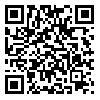Volume 17, Issue 2 (9-2024)
ijhe 2024, 17(2): 245-260 |
Back to browse issues page
Download citation:
BibTeX | RIS | EndNote | Medlars | ProCite | Reference Manager | RefWorks
Send citation to:



BibTeX | RIS | EndNote | Medlars | ProCite | Reference Manager | RefWorks
Send citation to:
Niknejad H, Gholami-Borujeni F, Sajjadpour K, Mojerlou S, Ghasemnejad R, Rafiee M. Evaluation of compliance with hygiene guidelines and microbial load of hands in bakery workers of Mahmoudabad city. ijhe 2024; 17 (2) :245-260
URL: http://ijhe.tums.ac.ir/article-1-6879-en.html
URL: http://ijhe.tums.ac.ir/article-1-6879-en.html
Hadi Niknejad1 
 , Fathollah Gholami-Borujeni2
, Fathollah Gholami-Borujeni2 
 , Khadijeh Sajjadpour3
, Khadijeh Sajjadpour3 
 , Samira Mojerlou4
, Samira Mojerlou4 
 , Reza Ghasemnejad5
, Reza Ghasemnejad5 
 , Mohammad Rafiee *
, Mohammad Rafiee * 
 6
6

 , Fathollah Gholami-Borujeni2
, Fathollah Gholami-Borujeni2 
 , Khadijeh Sajjadpour3
, Khadijeh Sajjadpour3 
 , Samira Mojerlou4
, Samira Mojerlou4 
 , Reza Ghasemnejad5
, Reza Ghasemnejad5 
 , Mohammad Rafiee *
, Mohammad Rafiee * 
 6
6
1- Student Research Committee, Department of Environmental Health Engineering, School of Public Health and Safety, Shahid Beheshti University of Medical Sciences, Tehran, Iran AND Department of Environmental Health Engineering, School of Public Health and Safety, Shahid Beheshti University of Medical Sciences, Tehran, Iran
2- Department of Environmental Health Engineering, Faculty of Health, Mazandaran University of Medical Sciences, Sari, Iran
3- Department of Psychology, Faculty of Educational Sciences and Psychology, Payame Noor University, Amol, Iran
4- Behshahr Health Center, Deputy of Health, Mazandaran University of Medical Sciences, Behshahr, Iran
5- Mahmoudabad Health Center, Deputy of Health, Mazandaran University of Medical Sciences, Mahmoudabad, Iran
6- Department of Environmental Health Engineering, School of Public Health and Safety, Shahid Beheshti University of Medical Sciences, Tehran, Iran ,rafieemohammad909@gmail.com
2- Department of Environmental Health Engineering, Faculty of Health, Mazandaran University of Medical Sciences, Sari, Iran
3- Department of Psychology, Faculty of Educational Sciences and Psychology, Payame Noor University, Amol, Iran
4- Behshahr Health Center, Deputy of Health, Mazandaran University of Medical Sciences, Behshahr, Iran
5- Mahmoudabad Health Center, Deputy of Health, Mazandaran University of Medical Sciences, Mahmoudabad, Iran
6- Department of Environmental Health Engineering, School of Public Health and Safety, Shahid Beheshti University of Medical Sciences, Tehran, Iran ,
Abstract: (377 Views)
Background and Objective: Personal hygiene and adherence with health protocols in food preparation and distribution centers by operators are essential for controlling the transmission of infectious diseases. This study aimed to investigate the microbial contamination and compliance with health protocols among bakery workers in Mahmoudabad, Mazandaran, in 2020.
Materials and Methods: In a cross-sectional descriptive study, 149 samples were collected from the hands of workers in bakeries in Mahmoudabad. The microbial load was determined using the System Sure Plus device. Additionally, standard checklists, which included questions related to compliance with health protocols in the workplace, were used. The collected data was then analyzed using SPSS 26 software.
Results: Among the studied samples, 51.1%had a microbial load higher than 30 RLU (Relative Light Units), 28.86% had a microbial load of 10-30 RLU and 20.13% had a microbial load less than 10 RLU. Based on the results of the checklists, the rates of adherence to hand disinfection protocol, observance of social distancing, use of liquid soap, and use of a mask were 43.6%, 61.7%, 59.7%, and 53.7%, respectively. Additionally, data analysis revealed a significant relationship between business gown usage and microbial contamination on personnel's hands (p = 0.031).
Conclusion: Based on the results, it was evident that the workers' hand hygienewas in a concerning condition, posing a potential threat to their overall well-being. Therefore, individual health education and food safety practices should be improved, and inspections by environmental health monitors should be considered to ensure stricter public health standards.
Materials and Methods: In a cross-sectional descriptive study, 149 samples were collected from the hands of workers in bakeries in Mahmoudabad. The microbial load was determined using the System Sure Plus device. Additionally, standard checklists, which included questions related to compliance with health protocols in the workplace, were used. The collected data was then analyzed using SPSS 26 software.
Results: Among the studied samples, 51.1%had a microbial load higher than 30 RLU (Relative Light Units), 28.86% had a microbial load of 10-30 RLU and 20.13% had a microbial load less than 10 RLU. Based on the results of the checklists, the rates of adherence to hand disinfection protocol, observance of social distancing, use of liquid soap, and use of a mask were 43.6%, 61.7%, 59.7%, and 53.7%, respectively. Additionally, data analysis revealed a significant relationship between business gown usage and microbial contamination on personnel's hands (p = 0.031).
Conclusion: Based on the results, it was evident that the workers' hand hygienewas in a concerning condition, posing a potential threat to their overall well-being. Therefore, individual health education and food safety practices should be improved, and inspections by environmental health monitors should be considered to ensure stricter public health standards.
Type of Study: Research |
Subject:
General
Received: 2023/12/23 | Accepted: 2024/07/2 | Published: 2024/09/16
Received: 2023/12/23 | Accepted: 2024/07/2 | Published: 2024/09/16
Send email to the article author
| Rights and Permissions | |
 |
This work is licensed under a Creative Commons Attribution-NonCommercial 4.0 International License. |



